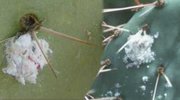Cochineal
|
|
Cochineal (Coccus cacti or Dactylopius coccus ) is a scale insect in the order of Homoptera, indigenous to Mexico. A parasite, it lives primarily on the prickly pear cactus by feeding on moisture in its leaves.
Cochineal is also the name given to the crimson or carmine colored dye made from the dried bodies of the females (in the case of "cochineal") or the crushed eggs (in the case of cochineal extract).
| Contents |
The Insect
Cochineal_drawing.jpg
Cochineals are soft-bodied, flat, oval-shaped insects that cluster on plants. They secrete a waxy white substance over their bodies for protection. The feeding of the female cochineal often causes damage and sometimes kills the host cactus plant. Adult males have wings, are tiny, and cannot feed at all. They only live long enough to fertilize the eggs. Immature males can feed for a short time.
The Dye
A deep crimson dye is extracted from the Cochineal insect female.
Dye Production
The insects are collected at approximately age of ninety days; it is a highly labor-intensive activity. The insects are killed by either immersion in hot water or by exposure to sunlight, steam, or the heat of an oven. The variety in the appearance of commercial cochineal is caused by these differing methods. It takes around 70,000 insects to make one pound of cochineal. The coloring comes from carminic acid.
History
The cochineal was used by the Aztecs. After the arrival of the Spanish conquistadors, it was introduced to Europe during the 17th century. The Mexican city of Oaxaca, Oaxaca, and its hinterland owed much of its prosperity in the 17th and 18th centuries to the cochineal trade. It has since been imported to and cultivated in other locations, such as Peru and the Canary Islands, where it became a lucrative export.
In the course of the 20th century, trade in cochineal diminished, as it was replaced by synthetic compounds. In recent years it has become commercially valuable again, because unlike many commercial synthetic red dyes, it is non-toxic and not carcinogenic (this is a point of controversy - see a section below).
Usage
Cochineal-dyed-wool.jpg
Traditionaly cochineal was used for coloring fabrics. Now it is used as a fabric and cosmetics dye and as a natural food coloring, as well as for oil paints and watercolours. When used as a food additive, the dye may be labelled as E120 on packaging labels.
The water soluble form is used in alcoholic drinks with calcium carmine, the insoluble form, being used in a wider variety of products. Together with ammonium carmine they can be found in alcoholic drinks, bakery products and toppings, biscuits, desserts, drinks, icings, pie fillings, variety of cheddar cheese, sauces and sweets. It is also thought to give Campari and other Italian aperitifs their color.
Controversy
An unknown percentage of people have been found to have allergies to carmine, ranging from mild cases of hives, to anaphylactic shock. Cochineal is one of the colors that the Hyperactive Children's Support Group recommends be eliminated from the diet of hyperactive children.
Natural carmine dye used in foods can render them rather unattractive to vegetarian consumers, since insects are used in dye production (see above).
Foodstuffs containing carmine are considered haraam (forbidden) by Muslims.de:Koschenille nl:Karmijn es:Cochinilla pt:Cochonilha vi:Bọ yên chi

